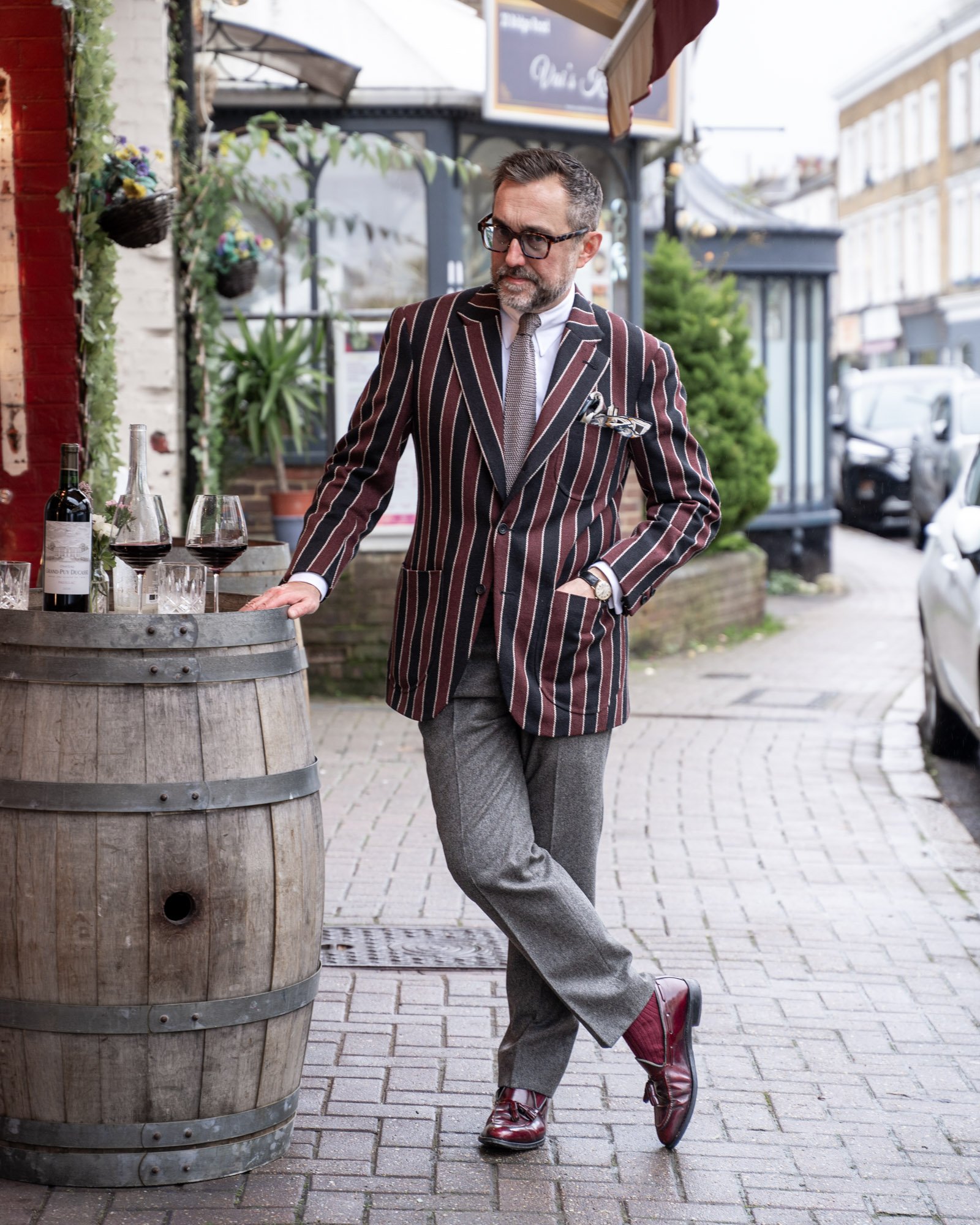(5) The Final Cut
Written by Chris Modoo , Photography by James Ryan Campbell & Macaulay Lawes
The first (of many, I hope) special cloths to be commissioned by TSC was an inspired choice. While a house tweed or perhaps a tartan might have been a more expected route, we opted for something different—a sporting stripe. Produced in a very limited edition with The House of Tengri, using their luxurious and sustainably sourced Mongolian yak , this cloth brings bespoke sensibility to modern weaving. The black, silver, and red design evokes a subtle Ivy League feel, so to fully capture the Anglo-American aesthetic, we partnered with Matthew Gonzalez. Not only is he a skilled tailor, but he also has an intrinsic understanding of this look.
The Three Pillars of Tailoring: Cloth, Design, and Craft
When it comes to bespoke or made-to-measure tailoring, I always share a few key principles with my clients. Over the years, working for heritage brands and advising countless customers, these three essentials have guided me—and should guide you too. Whether you’re commissioning your first garment or are a seasoned sartorialist, these rules are vital:
Respect the Cloth
Tailoring begins and ends with the fabric. It’s not just a piece of material—it’s the soul of your suit. The way it moves, feels, and behaves is integral to how the garment will perform over time. My creative journey always starts with the cloth. Whether I’m at fabric fairs in Como or Paris, visiting mills in Scotland, or perusing a tailor’s bunch in a Savile Row basement, the cloth comes first. Every fabric tells a story, and woven into its fibres is a legacy of craftsmanship. Take the TSC Stripe, reminiscent of the Regatta stripes of the 19th century: it’s full of character, integrity, and a hint of drama. It’s a robust cloth that will only improve with wear.
Respect the Design
Tailoring is an art form, and design is its blueprint. The black, red, and silver stripes of our first house cloth, evocative of the boating jackets worn at Regattas since the 19th century, carry strong class associations. Yet, there’s joy in subtly subverting such traditions. Always respect the design, but make sure the pattern complements the chosen cut.
Respect the Tailor
A suit is a collaboration between the wearer and the maker. Your tailor isn’t just executing your vision—they’re bringing years of expertise to the table. Respect their craft, and trust their judgment. Play to your tailor’s strengths, but don’t be afraid to ask questions (unless it’s about belt loops with formal dress—never ask that!).
When Tradition Meets Modern Tailoring
Working with Matthew Gonzalez, we’ve fully embraced these principles. His authentic Anglo-American aesthetic aligns perfectly with the Ivy League associations of the sporting blazer. He’s the ideal artisan, blending top-end craftsmanship with a modern sensibility. And perhaps most importantly, he appreciates the value of being part of such a prestigious project.
We began with the quintessential single-breasted blazer in the “button 3, roll 2” style. This sparked an existential tailoring question: is this a three-button coat pressed into a two-button look, or a two-button style with an additional buttonhole? Matthew cuts the latter but assures me the top button is fully functional. While I like both approaches, we agreed that the latter is the preferred bespoke option. A moderate 3 ¼” lapel with a subtle belly ensures balance and harmony.
We also decided this style would look best without front darts, allowing the bold design to remain uninterrupted. This decision is supported by vintage illustrations and photographs, with a nod to the original sack suit. However, our jacket will retain shape through clever side-body manipulation, avoiding a boxy silhouette. Three patch pockets, shaped like red wine goblets, will grace the front. Without the interruption of front darts, the pockets align beautifully, and only the keenest eye will appreciate their subtle curves. The buttons will be black matte horn with two eyelets (classic Savile Row style), and the buggy lining will be a tonal black viscose.
The shoulder line will be natural and ever so gently extended, with no roping, complementing the sporty aesthetic. An offset seam will enhance the continuous lines of the pattern—a tricky feature when fitting clients with forward-facing shoulders, a common figuration among rowers (oh, the irony!). The overall fit will be easy yet shaped, with a long body and a centre “hook vent.”
Effortless Styling: The Blazer for Every Occasion
This is a jacket designed to be thrown on casually, much like an old tweed or corduroy blazer. I imagine it as something Patrick McGoohan might have worn in The Prisoner—perfect with a knitted top, slim-leg drills, and canvas sneakers, though it would look equally sharp paired with jeans and loafers. It complements grey magnificently, and I enjoyed wearing it with my flannels, white tab-collar shirt, and smoke-grey silk knitted tie.
Unlimited Bespoke Possibilities with Limited Edition Cloth
Of course, this is bespoke, so I’m sure our TSC members will indulge their creativity. The yak cloth would make an excellent topcoat or even a smoking jacket with quilted satin lapels. And if any remnant cloth remains after this project, I’d be tempted to commission a pair of evening trousers with a braided side seam, to be worn with a black dinner jacket—high-waisted, flat-fronted, and naturally, no belt loops!
In a world where “limited edition” is often overused, this truly is! It’s a prototype or first edition, if you like, with only enough cloth for ten jackets availabe. And (unlike many bespoke commissions) you have the benefit of seeing a finished garment and perhaps even trying it on. But you could do a lot worse than visiting Matthew and bespeaking one just like this.










